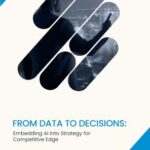or call: +1 (845) 347-8894

or call: +1 (845) 347-8894

Walk into any tech boardroom today, and you’ll hear one term buzzing louder than ever: demand generation strategy. Everyone’s chasing demand. Not just leads, not just clicks, but genuine, lasting interest from people who are ready to engage, ready to buy, and more importantly, ready to stay.
Let’s take a step back, though. What is meant by demand generation? Why is it so important in today’s tech industry? And how can you create a plan that creates genuine momentum rather than merely checking boxes?
This beginner’s guide breaks it all down. No jargon. No fluff. Just real insight and action.
Marketing is only one aspect of demand generation. It’s not an eye-catching advertising campaign or a lead form that you just put on your website. It’s the entire process, the art (and science) of drawing in, educating, and developing potential customers until they’re not only prepared to buy, but eager to do so.
Think of it this way: Lead generation gets you names. Demand generation builds relationships.
In the tech world, where buyers are skeptical, budgets are scrutinized, and every purchase involves layers of decision-makers, demand gen is your competitive advantage. It’s how you move from just another vendor to a go-to problem solver.
And it works. According to Salesforce’s 2024 State of Marketing Report, 77% of global marketers say their top priority is improving lead and demand generation strategies that directly connect to revenue impact.
The real question isn’t whether you need demand generation. It’s how fast can you start?
People don’t just stumble onto your website and decide to buy a $50,000 cloud solution. They read, ask. and compare. Demand gen is the bridge between curiosity and conversion.
Every tech company wants to be seen as an innovator. But only those who show up consistently through blogs, webinars, reports, and thought leadership earn that authority. Demand generation keeps your brand in the spotlight for the right reasons.
A good demand generation strategy doesn’t flood your CRM with random emails. It delivers high-fit, high-intent leads that your sales team can close.
One of the biggest silent killers in tech marketing? Misalignment. Demand generation encourages a shared roadmap with sales and marketing pulling in the same direction, tracking the same KPIs, and closing the same deals.
Lead gen can win you a sprint. Demand gen wins you the marathon. It creates a pipeline that gets stronger over time, not weaker. The result is predictable growth, quarter after quarter.
Now the fun part. Let’s talk strategy specifically, what works in tech, where attention spans are short, solutions are complex, and the buying process feels more like a committee vote than a solo decision.
Here are five demand generation strategies that deliver, even in the most saturated markets:
Before you sell anything, teach something.
Build content that solves real problems. If you’re a SaaS company solving team collaboration bottlenecks, create a guide like “The Hidden Cost of Context Switching in Remote Teams.” Show them you understand their pain. Then offer a solution.
Think blogs, downloadable templates, email mini-courses, and technical explainers. The goal is to be useful first and promotional later.
Pro Tip: Repurpose long-form content into bite-sized assets across LinkedIn, email, and paid ads to increase visibility without reinventing the wheel.
Spray-and-pray ads are out. Intent-based targeting is in.
Platforms like LinkedIn and Google Ads allow you to target based on job title, company size, industry, and even search behavior. That means your messaging hits exactly when your audience is looking for answers.
Couple this with sharp copy such as “How CIOs Are Cutting SaaS Costs Without Cutting Features” and a strong CTA, and you’re not just running ads, you’re starting conversations.
Webinars aren’t dead. Boring webinars are.
Today’s tech buyers want substance. Host product walkthroughs, expert roundtables, or trend-focused sessions like “How AI Is Changing Cloud Infrastructure in 2025.” Bring in guest voices. Make it interactive. Record and gate it for a long period of lead capture.
One-size-fits-all messaging doesn’t fly in B2B tech. Enter ABM customized campaigns for valuable accounts.
Use intent data to identify companies researching your solutions. Build custom landing pages for each segment. Tailor your outreach. ABM takes more effort, but the payoff is bigger deals, faster closes, and deeper relationships.
You’ve got leads. Now what?
Make nurture-oriented workflows. Instead of generic newsletters, consider email drips that react to user behavior. Provide a case study demonstrating how your solution increased compliance after someone receives your whitepaper on zero-trust architecture.
It’s not just about staying in touch. It’s about being contextually relevant at every turn.
You’re guessing if you’re not monitoring performance. And guesses are costly in the computer industry. Here’s what to monitor in your demand generation strategy:
Demand generation is long-game marketing. Don’t expect overnight wins. But do expect compounding returns, especially when you continuously optimize based on real data.
Good news: You don’t need a six-figure budget or a 10-person team to launch your demand gen engine.
Start small:
The goal isn’t to build a massive machine overnight. It’s to create momentum, and you can do that with clarity, consistency, and creativity.
Use free tools where possible. Lean into platforms like LinkedIn, Substack, or even short video explainers to tell your story. Ask your sales team what prospects are always asking about and turn that into your first content asset.
Then test, learn, and refine. Demand gen isn’t about perfection. It’s about progress. And in tech, progress is everything.
In a world chasing instant results, demand generation rewards the ones who show up consistently. It’s about building trust, solving problems, and offering value long before a sale is on the table.
As Gartner highlights:
“B2B buyers are 1.8 times more likely to complete a high-quality deal when they engage with supplier-provided digital tools in partnership with a sales rep rather than independently.”
That’s the kind of relationship tech buyers want. And in 2025, it’s the kind that wins.
Demand generation focuses on creating awareness and interest throughout the entire buyer journey, building trust, and educating prospects. Lead generation is more narrowly focused on capturing contact information from potential buyers, often later in the buying process.
Demand generation is a long-term approach. While some early wins can happen in weeks, meaningful results typically build over months as trust grows and content gains traction.
Educational content, such as how-to guides, webinars, case studies, whitepapers, and industry reports, works well. The key is to provide value that addresses real customer pain points and questions.
Absolutely. Demand generation can scale to fit any size business. Small teams can start with targeted content and simple nurture campaigns, growing their efforts as they learn and gain momentum.
Track marketing-qualified leads (MQLs), conversion rates at each funnel stage, engagement metrics on content, and most importantly, how many leads convert into closed deals influenced by your campaigns.
To participate in our interviews, please write to our IntentTech Media Room at sudipto@intentamplify.com




